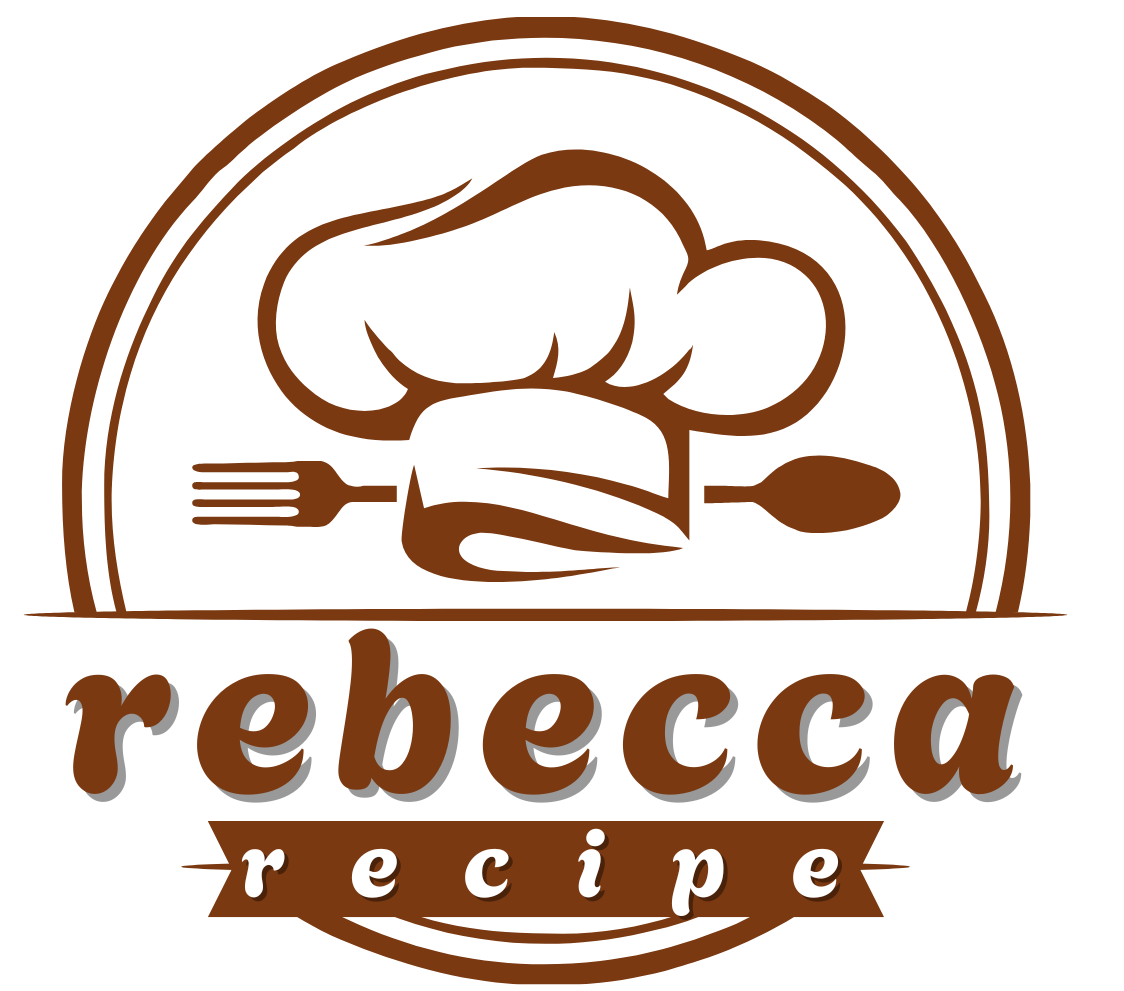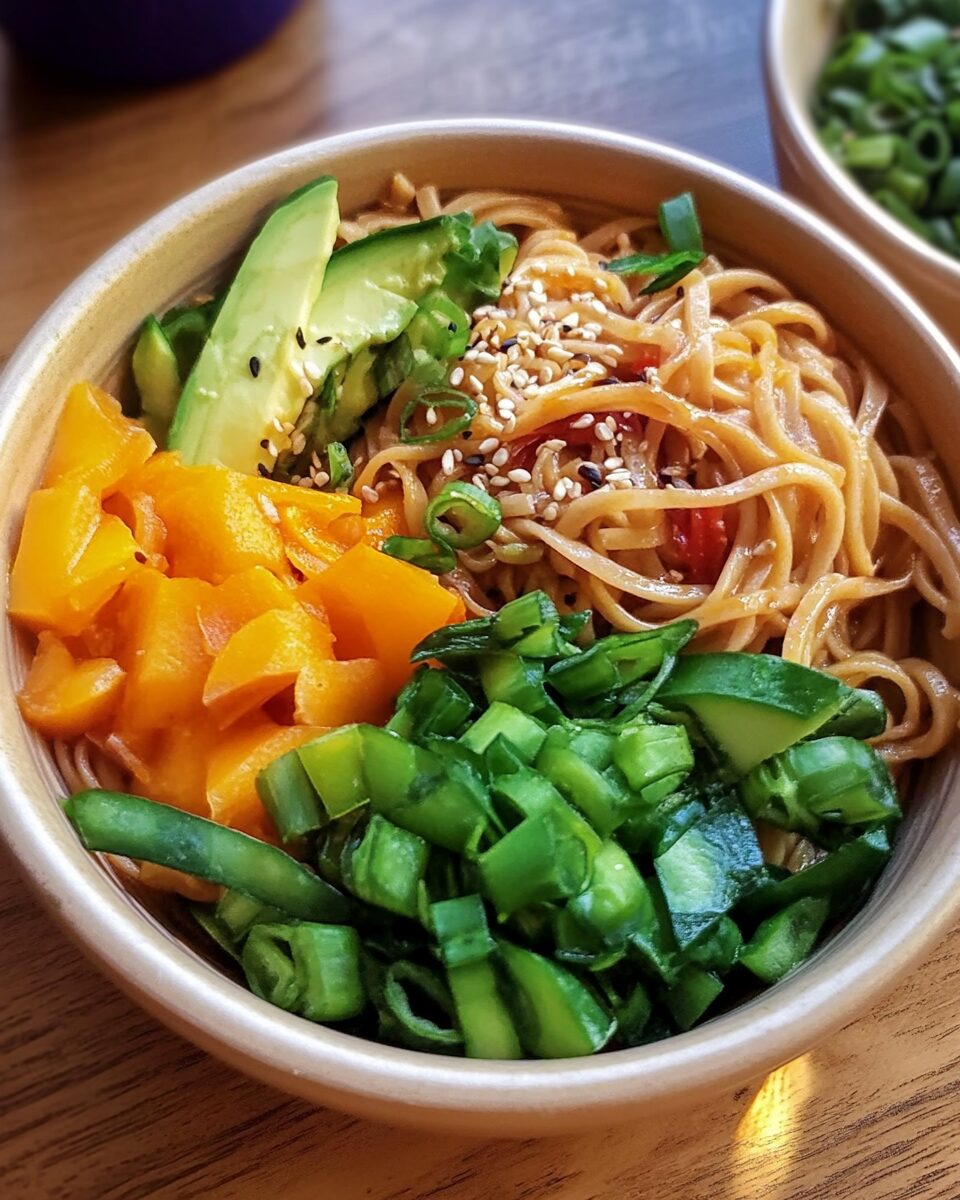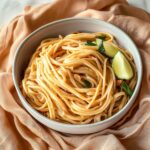This Soba Noodle Veggie Bowl is a healthy and flavorful meal that combines soba noodles with a variety of fresh vegetables, all tossed in a light sesame dressing. It’s perfect for a light lunch or dinner, offering a satisfying balance of textures and flavors.
Full Recipe:
Ingredients
- 8 ounces soba noodles
- 2 tablespoons sesame oil
- 1 tablespoon rice vinegar
- 1 tablespoon soy sauce
- 1 tablespoon honey
- 1 tablespoon sesame seeds
- 1/2 teaspoon red pepper flakes (optional)
- 1 cucumber, julienned
- 1 carrot, julienned
- 1/2 bell pepper, thinly sliced
- 1/4 cup green onions, sliced
- 1/4 cup fresh cilantro, chopped
- 1/4 cup edamame (optional)
- 1 tablespoon toasted sesame seeds for garnish
Directions
- Cook soba noodles according to package instructions, then drain and rinse under cold water to stop the cooking process.
- In a small bowl, whisk together sesame oil, rice vinegar, soy sauce, honey, and red pepper flakes (if using).
- In a large bowl, combine the cooked soba noodles with cucumber, carrot, bell pepper, green onions, cilantro, and edamame.
- Pour the sesame dressing over the noodles and toss everything together to coat evenly.
- Garnish with toasted sesame seeds and serve chilled or at room temperature.
Nutrients
- Calories: 250 per serving
- Total Fat: 14g
- Saturated Fat: 2g
- Cholesterol: 0mg
- Sodium: 350mg
- Total Carbohydrates: 27g
- Dietary Fiber: 4g
- Sugars: 9g
- Protein: 6g
Why Soba Noodles Are Special
At the heart of this dish is the soba noodle—a traditional Japanese noodle made primarily from buckwheat flour. Unlike conventional pasta, soba noodles are known for their unique nutty flavor and slightly earthy aroma. They also boast a delicate texture that pairs wonderfully with crisp vegetables and light sauces.
Soba noodles are celebrated not just for their taste but also for their nutritional profile. Buckwheat, despite its name, is not related to wheat and is naturally gluten-free (though some commercial soba noodles may contain a blend of wheat flour, so always check labels if gluten is a concern). Buckwheat is rich in fiber, manganese, magnesium, and essential amino acids. It also has a low glycemic index, making it an excellent choice for those managing blood sugar levels.
The Nutritional Appeal of the Veggie Bowl
What sets this bowl apart is its combination of health-forward ingredients. The vegetables in a Soba Noodle Veggie Bowl are not only visually appealing but also contribute significantly to the meal’s nutritional value. Depending on what’s in season or your personal preferences, the veggie bowl can be filled with an array of colors—bright carrots, deep green broccoli or kale, vibrant bell peppers, and purple cabbage.
These ingredients add a wealth of fiber, vitamins, and antioxidants to your diet. The fiber aids digestion and satiety, while the vitamins (especially A, C, and K) and minerals (such as potassium and iron) support immune health, skin vitality, and overall energy levels.
The dressing typically used in this recipe often includes a combination of soy sauce, sesame oil, rice vinegar, and other aromatic elements. This adds not only rich flavor but also heart-healthy fats and umami depth that ties everything together without needing heavy sauces or creams.
A Perfect Fit for Plant-Based Lifestyles
As more people embrace plant-based eating, the Soba Noodle Veggie Bowl stands out as a go-to dish. It’s entirely plant-based yet deeply satisfying, even for those accustomed to meat-centric meals. The clever layering of flavors and textures compensates for any lack of animal protein, making it a popular choice among vegans, vegetarians, and flexitarians.
However, if you want to increase protein content, this dish is easily adaptable. Tofu, tempeh, edamame, or chickpeas can be added without disrupting the dish’s harmony. For those who prefer animal proteins, grilled chicken, shrimp, or a soft-boiled egg can also complement the dish beautifully.
Meal Prep Friendly and Time Efficient
One of the biggest advantages of the Soba Noodle Veggie Bowl is its suitability for meal prep. You can prepare the noodles and vegetables in advance, store them separately or together, and simply toss with dressing when you’re ready to eat. Unlike salads that wilt quickly or cooked meals that lose texture after refrigeration, this bowl maintains its freshness and flavor for days.
It’s also an excellent option for those with busy schedules. The cooking process is straightforward, and the entire dish can be assembled in under 30 minutes. It’s ideal for weekday lunches, post-gym refuels, or even dinner on hectic nights.
A Canvas for Customization
The Soba Noodle Veggie Bowl is a highly adaptable dish. It welcomes personalization based on taste, dietary needs, or pantry availability. Here are some ideas to make it your own:
- Add a protein punch: Include grilled tofu, seared tempeh, marinated chickpeas, or even lentils.
- Spice it up: Add chili oil, red pepper flakes, or a drizzle of sriracha for a fiery kick.
- Play with textures: Include roasted chickpeas, chopped nuts, or toasted seeds for added crunch.
- Incorporate herbs: Fresh cilantro, basil, mint, or scallions can brighten the flavor profile.
- Switch the noodles: Try zucchini noodles, rice noodles, or whole wheat soba for variety.
This versatility makes the dish perfect for any season and easily adaptable to dietary restrictions, preferences, or creative experiments.
Flavor Harmony and Balance
Every successful dish comes down to the balance of taste, and the Soba Noodle Veggie Bowl excels in this arena. The interplay of nutty soba noodles, crisp vegetables, and savory dressing delivers a perfectly balanced flavor profile. The umami from soy sauce, tang from vinegar, nuttiness from sesame oil, and gentle sweetness from optional honey or maple syrup create a taste that is simultaneously comforting and exciting.
A few fresh garnishes like sesame seeds or lime wedges can enhance the experience, delivering bursts of texture and brightness that elevate the dish from simple to exceptional.
Eco-Friendly and Sustainable Eating
As sustainability becomes more important in everyday choices, meals like the Soba Noodle Veggie Bowl contribute positively to a greener lifestyle. It encourages local and seasonal produce use, reduces dependency on animal products, and minimizes food waste. Leftover vegetables or herbs in your fridge can easily be added to this bowl, preventing unnecessary waste while enhancing the dish’s flavor and diversity.
By eating more plant-based meals like this one, you reduce your carbon footprint and contribute to a healthier planet, all while enjoying flavorful and fulfilling food.
Presentation and Visual Appeal
The Soba Noodle Veggie Bowl is a treat for the eyes as much as it is for the palate. Its presentation can range from rustic to restaurant-level chic. Here are a few styling tips:
- Arrange vegetables in colorful clusters or layers for a vibrant contrast.
- Use a wide, shallow bowl to showcase the full visual spectrum of ingredients.
- Top with a scattering of black or white sesame seeds for elegance.
- Drizzle the dressing lightly over the top before tossing for a glossy finish.
- Add edible flowers or microgreens for gourmet flair.
These touches not only make the meal Instagram-worthy but also make eating feel more joyful and intentional.
Ideal for Every Occasion
Whether you’re preparing a solo lunch, a dinner for two, or a potluck contribution, the Soba Noodle Veggie Bowl fits every scenario. It’s easy to scale up for a crowd or pare down for a quick personal meal. Its universal appeal also makes it a great option for hosting—guests with various dietary needs can enjoy the dish without worry.
Moreover, since it’s served cold or at room temperature, you don’t have to stress about reheating or maintaining temperature, making it ideal for events, buffets, or outdoor gatherings.
A Gateway to Global Flavors
The Soba Noodle Veggie Bowl offers an approachable way for people to explore Japanese and Asian-inspired flavors without requiring specialized culinary knowledge or hard-to-find ingredients. It introduces essential Asian pantry staples—like sesame oil, soy sauce, and rice vinegar—while using accessible vegetables and noodles.
For many home cooks, this dish becomes a gateway into experimenting with more global cuisine, encouraging a more adventurous and diverse kitchen experience.
Budget-Friendly and Accessible
Despite its gourmet flair, the Soba Noodle Veggie Bowl is surprisingly budget-friendly. The ingredients are commonly available and relatively inexpensive. You don’t need premium cuts of meat or exotic produce to make a standout version of this dish.
This affordability makes it an excellent choice for students, families, or anyone managing grocery budgets while still wanting nourishing, flavorful meals.
The Joy of Mindful Eating
Beyond nutrition and flavor, there’s something inherently mindful about enjoying a Soba Noodle Veggie Bowl. The process of preparing, assembling, and savoring the textures and flavors promotes a slower, more intentional eating experience.
In an era where fast food and rushed meals dominate, dishes like this encourage reconnection with food, flavor, and well-being. They remind us that eating well doesn’t have to be complicated—it can be simple, beautiful, and deeply fulfilling.
Conclusion
The Soba Noodle Veggie Bowl is more than just a recipe—it’s a celebration of healthy, flavorful, and sustainable eating. It brings together the nourishing power of whole foods, the complexity of Asian-inspired flavors, and the ease of modern cooking. It’s a dish that anyone can enjoy, regardless of skill level or dietary preference.






